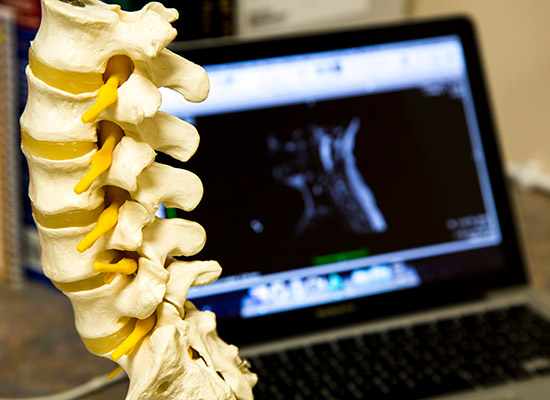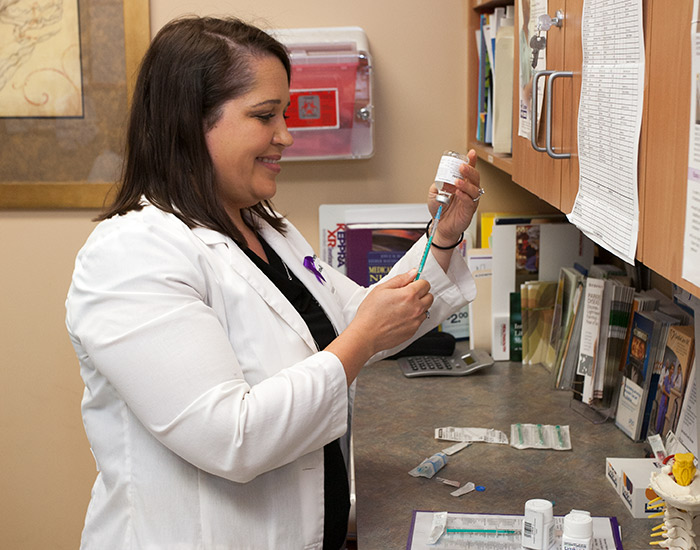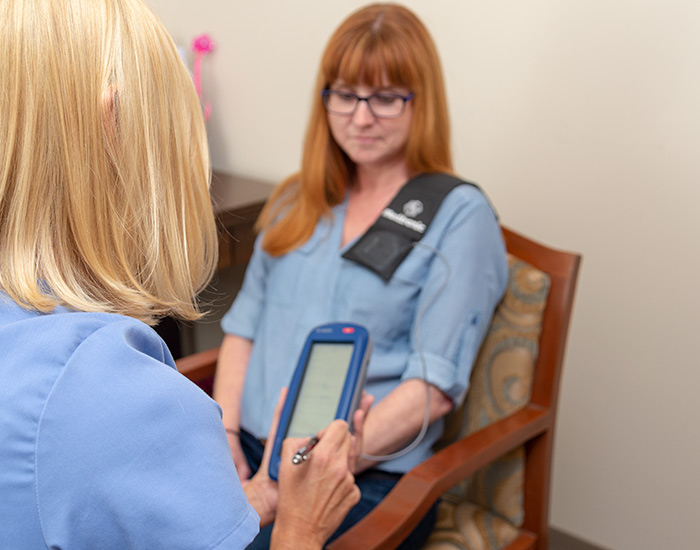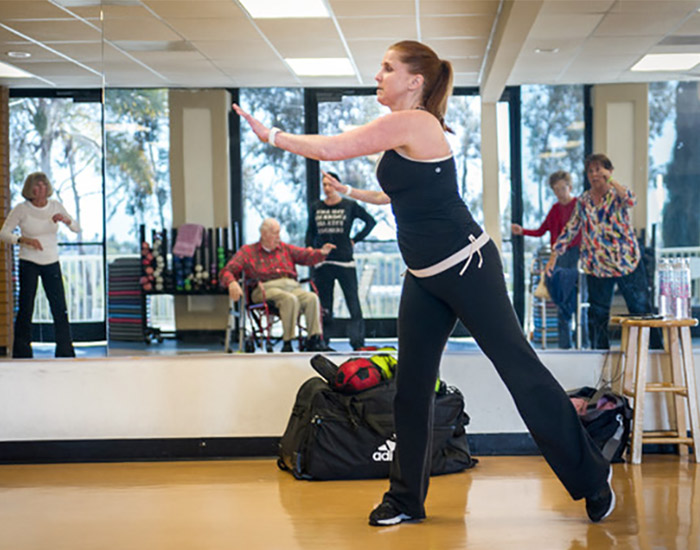Clinic
Neurology/Movement Disorders
Movement Disorder is a term which commonly refers to the abnormal, uncontrolled movements of the arms, hands, head, neck and legs that can cause difficulty with walking, talking, or completing other simple daily tasks. Patients often display tremors or difficulty rising from a chair. Activities may take longer than normal to complete and there may be some stiffness or slowness when walking.
Other patients present symptoms by speaking too softly or notice a sudden change handwriting or the patient’s face may lack expression or animation. Parkinson’s disease is just one example of a neurological movement disorder; others include Essential Tremor, Huntington’s disease, Tourette’s, ALS, PSP and Dystonias.
While there is no known cure for these disorders at the Neurology and Pain Specialty Center we focus on diagnosing and providing comprehensive disease management plans that may include:
- Medication management
- Diet and nutrition
- Exercise/fitness classes
- Physical, occupational, or speech therapy
- Surgical therapy options
- Patient and caregiver support groups

Specialized care we offer:

Medication Management
Dr. Martinez and your Advanced Practitioner can help you determine the best treatment plan for your diagnosis and symptoms. Each patient is assessed, an individual treatment plan is created and we will initiate symptomatic treatment of the most bothersome symptoms or those causing functional disability. Although there is no cure for Parkinson’s at this time, medication/surgical options and complementary therapies used to treat Parkinson’s disease and other neurologic movement disorders are continually improving.
Several classes of medication are available to treat Parkinson’s symptoms including Dopamine Agonists, COMT Inhibitors, MAO Inhibitors, and Anticholinergic agents. Carbidopa/Levodopa (Sinemet, Rytary, etc.) remains the most effective symptomatic therapy and may be used in combination with these other classes of medications. Significant research and development is going into this area for improved medications for motor symptoms (tremor, stiffness, slowness) and expanded options for non-motor symptoms (depression, sleep disturbances, low blood pressure).


How Deep Brain Stimulation Works
Video courtesy of Boston Scientific
Device Therapies
Dr. Martinez and our Movement Disorder team may consider “Surgical Therapies” as an option for you during the course of your Parkinson’s disease (PD) treatment, especially if your symptoms, such as tremor, rigidity, stiffness, slowed movement, and walking problems cannot be adequately controlled with oral medication.
Similar to all of the presently available medications, surgical options offer symptomatic benefit. Deep brain stimulation (DBS) uses a surgically implanted, battery-operated medical device called an implantable pulse generator (IPG) — similar to a heart pacemaker and approximately the size of a stopwatch to — deliver electrical stimulation to specific areas in the brain that control movement, thus blocking the abnormal nerve signals that cause PD symptoms. This procedure is most commonly used to treat the debilitating motor symptoms of Parkinson’s disease (PD) but it’s also used to treat Essential Tremor and Dystonia.
Before the procedure, a neurosurgeon uses magnetic resonance imaging (MRI) to identify and locate the exact target within the brain for surgical intervention. Our surgeons use microelectrode recording — which involves a small wire that monitors the activity of nerve cells in the target area — to more specifically identify the precise brain area that will be stimulated. Generally, these areas are the thalamus, subthalamic nucleus, and globus pallidus. There is a low chance that placement of the stimulator may cause bleeding or infection in the brain.
The DBS system consists of three components: the lead, the extension, and the IPG. The lead (also called an electrode)—a thin, insulated wire—is inserted through a small opening in the skull and implanted in the brain. The tip of the electrode is positioned within the specific brain area.
The extension is an insulated wire that is passed under the skin of the head, neck, and shoulder, connecting the lead to the implantable pulse generator. The IPG (the “battery pack”) is the third component and is usually implanted under the skin near the collarbone. In some cases it may be implanted lower in the chest or under the skin over the abdomen.
Once the system is in place, electrical impulses are sent from the IPG up along the extension wire and the lead and into the brain. These impulses block abnormal electrical signals and alleviate PD motor symptoms.
Although most individuals still need to take medication after undergoing DBS, many people with Parkinson’s disease experience considerable reduction of their motor symptoms and are able to reduce their medications. The amount of reduction varies but can be considerably reduced in most individuals, and can lead to a significant improvement in side effects such as dyskinesias (involuntary movements caused by long-term use of levodopa). In some cases, the stimulation itself can suppress dyskinesias without a reduction in medication. DBS does not improve cognitive symptoms in PD and indeed may worsen them, so it is not generally used if there are signs of dementia. DBS changes the brain firing pattern but does not slow the progression of the neurodegeneration.
Please see the Education section of our Glossary page for more information and resources.

Exercise & Fitness
Health and Exercise:
There are many factors that influence your overall health and it’s easy to overlook exercise. For our Movement Disorder Patients, exercise is a vital part of maintaining good balance, improving mobility and continuing to enjoy activities of daily living. Establishing early exercise habits is essential for overall disease management and research shows that our Parkinson’s patients who start exercising earlier and a minimum of 2.5 hours a week experience a slower decline in quality of life compared to those who start later.
Making excuses for not exercising? Read Allison’s blog for a little motivation.
Why is exercise so important?
At the Neurology & Pain Specialty Center, we understand that movement is life and should be a part of your daily activities. It is not encouraged as a temporary fix or a weekly habit; it should be a life style change in order to be your healthiest self. There is no “exercise prescription” that is right for every person with PD. The type of exercise you do depends on your symptoms and challenges. For sedentary people, just getting up and moving is beneficial. More active people can build up to regular, vigorous activity. Many approaches work well to help maintain and improve mobility, flexibility and balance to ease non-motor PD symptoms such as depression or constipation.
We can help you find an exercise program that includes a few key fitness ingredients:
- Flexibility (stretching) exercises
- Aerobic activity
- Resistance training or strengthening exercises
Some great local examples would be biking, running trails, Tai chi, yoga, Pilates, dance, weight training, non-contact boxing (Rock Steady Boxing), Qi Gong, Pep4U, and swimming.
Exercise can have Benefits:
- Improves mood and overall mental state
- Help with weight loss
- It is good for your muscles and bones
- Increases your energy levels and battles fatigue
- Reduces your risk of colds and flu
- Help overall skin health
- Improved brain health and memory
- Helps with regulating blood pressure
- Aids in digestion and prevents constipation
- Improves breathing
Challenges:
- People in early stages of PD tend to be just as strong and physically fit as healthy individuals of the same age.
- Disease progression can lead to the following physical changes:
- Loss of joint flexibility; can affect balance
- Decreased muscle strength or deconditioning can affect walking and the ability to stand up from sitting
- Decline in cardiovascular conditioning affects endurance
Tips for Getting Started
- First, be safe. Before starting a new exercise program, give Dr. Martinez or your Practitioner a call and let them know about any concerns and recommendations.
- Ask Dr. Martinez or your Practitioner to refer you to a physical therapist (PT) who knows about PD. Work together to identify your concerns and limitations. Target exercises to improve them. For most people, a structured exercise program will include aerobic exercise (such as brisk walking) and resistance training (using weights or bands).
- Purchase a pedometer (step-counter) and figure out how many steps you take on average each day, then build up from there. Many smartphones or smartwatches have a built-in pedometer feature or an application that can be downloaded. Come by and ask Allison at the office, we have pedometers and some great apps for your phone.
- Exercise indoors and outdoors. Change your routine to stay interested and motivated.
- Again, most importantly pick an exercise you enjoy.
Dr. Martinez and our team recognizes the importance of exercise that is why we provide a variety of services to help set attainable goals and modifications that give you the tools to be successful in achieving your healthiest self.
- Life coaching
- Psychotherapy
- Fitness classes
- Occupational therapy
Key Neurology/Movement Disorder Clinic Staff
-
-
-
-
-
-
-
Allison Smith, M.A., LMFT #90288 Licensed Marriage and Family Therapist, Certified Wellness Life Coach




